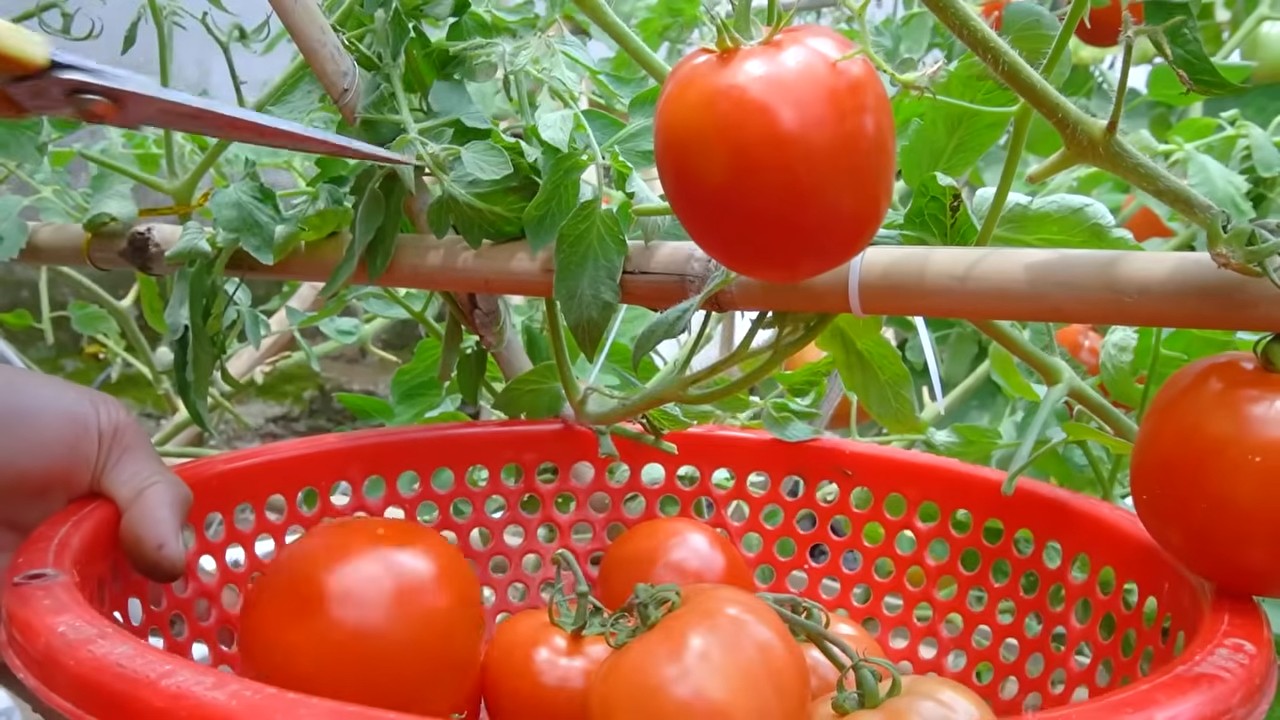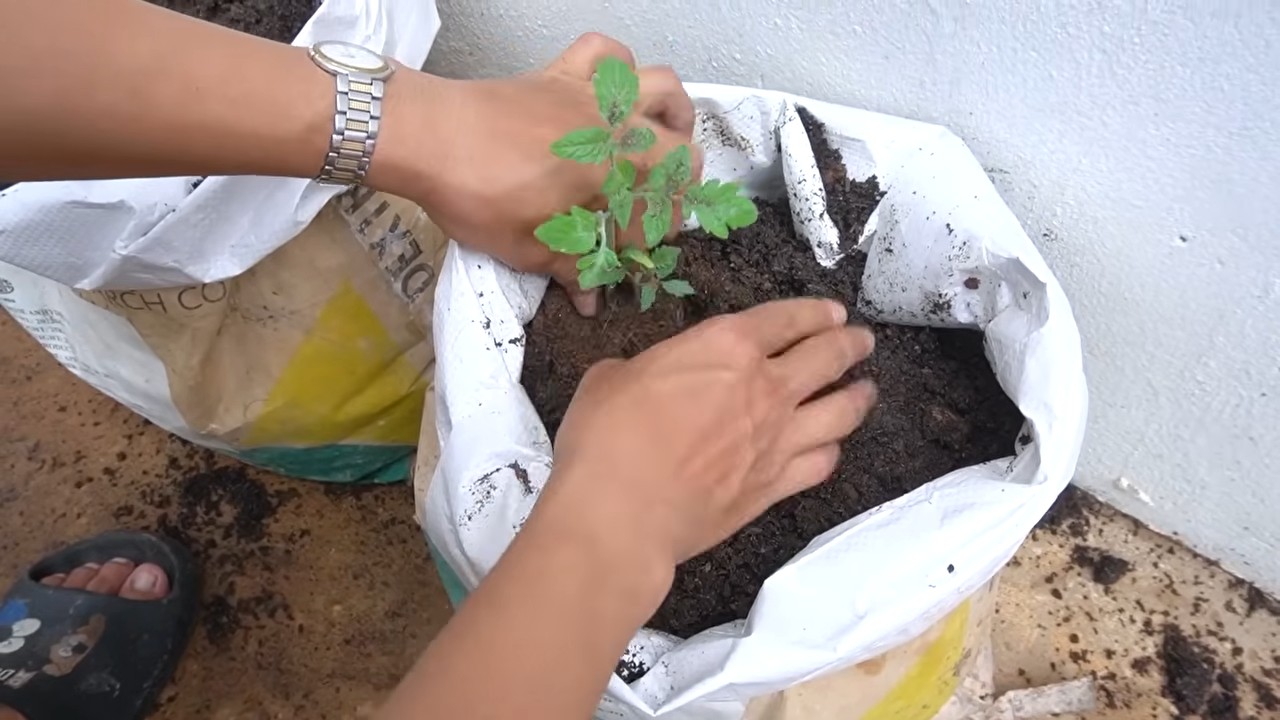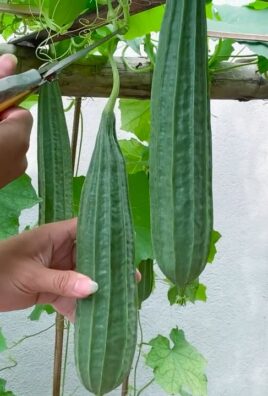Year-Round Tomato Production: Imagine biting into a juicy, sun-ripened tomato in the dead of winter, a burst of summer flavor when everything else is gray and cold. Sounds like a dream, right? Well, it doesn’t have to be! For centuries, gardeners have sought ways to extend the growing season, from ancient Roman greenhouses to modern-day hydroponics. The desire to nurture life and enjoy fresh produce, regardless of the weather, is deeply ingrained in us.
That’s why I’m so excited to share these amazing DIY tricks and hacks that will help you achieve year-round tomato production, no matter where you live! Forget bland, store-bought tomatoes – with a little ingenuity and these simple techniques, you can enjoy the vibrant taste of homegrown tomatoes all year long. We’ll explore everything from selecting the right varieties to creating the perfect indoor environment.
Why is this so important? Because access to fresh, healthy food shouldn’t be limited by the seasons. Plus, there’s something incredibly satisfying about growing your own food, knowing exactly where it came from and how it was nurtured. So, get ready to roll up your sleeves and discover the secrets to a continuous harvest of delicious, homegrown tomatoes!

DIY Year-Round Tomato Production: From Seed to Sauce, No Matter the Season!
Okay, tomato lovers, gather ’round! Are you tired of those bland, flavorless grocery store tomatoes, especially during the off-season? Do you dream of juicy, sun-ripened goodness all year long? Well, dream no more! I’m going to walk you through how to set up your own indoor tomato growing system, so you can enjoy fresh, delicious tomatoes whenever you want. It might seem daunting, but trust me, with a little planning and effort, you can absolutely do this!
Understanding the Basics: What Tomatoes Need to Thrive Indoors
Before we dive into the nitty-gritty, let’s talk about what tomatoes need to flourish indoors. It’s not just about throwing some seeds in a pot and hoping for the best. We need to mimic their ideal outdoor environment as closely as possible.
* Light: This is the BIG one. Tomatoes need a LOT of light – at least 6-8 hours of direct sunlight equivalent per day. Since we’re growing indoors, we’ll be relying on grow lights.
* Temperature: Tomatoes prefer daytime temperatures between 70-80°F (21-27°C) and nighttime temperatures between 60-70°F (15-21°C).
* Humidity: Aim for a humidity level between 40-60%. Too high, and you risk fungal diseases. Too low, and your plants will struggle to absorb water.
* Watering: Consistent watering is key, but avoid overwatering. The soil should be moist, not soggy.
* Nutrients: Tomatoes are heavy feeders, meaning they need a good supply of nutrients, especially during fruiting.
* Pollination: Since there won’t be any bees buzzing around indoors, we’ll need to hand-pollinate our plants. Don’t worry, it’s easier than it sounds!
* Support: Tomato plants, especially indeterminate varieties, can get quite large and will need support in the form of stakes, cages, or trellises.
Choosing the Right Tomato Variety
Not all tomato varieties are created equal, especially when it comes to indoor growing. Some are better suited for container gardening and indoor conditions than others. Here are a few of my favorites:
* Dwarf Varieties: These are compact and perfect for smaller spaces. Examples include ‘Tiny Tim,’ ‘Micro Tom,’ and ‘Venus.’
* Determinate Varieties: These grow to a certain size and then stop, producing all their fruit at once. They’re generally more manageable indoors than indeterminate varieties. ‘Roma’ and ‘Celebrity’ are good choices.
* Indeterminate Varieties: These continue to grow and produce fruit throughout the season. While they require more space and support, they can provide a continuous harvest. ‘Sweet Million,’ ‘Sungold,’ and ‘Black Cherry’ are popular options. If you choose an indeterminate variety, be prepared to prune it regularly.
Materials You’ll Need
Okay, let’s gather our supplies! Here’s a list of everything you’ll need to get started:
* Tomato Seeds: Choose a variety that’s well-suited for indoor growing.
* Seed Starting Trays or Pots: For starting your seeds.
* Seed Starting Mix: A light, well-draining mix specifically designed for seedlings.
* Larger Pots: At least 5-gallon pots for transplanting your seedlings.
* Potting Mix: A high-quality potting mix that’s well-draining and nutrient-rich.
* Grow Lights: LED grow lights are energy-efficient and provide the full spectrum of light that tomatoes need.
* Timer: To automate your grow lights.
* Fertilizer: A balanced fertilizer specifically formulated for tomatoes.
* Watering Can or Hose: For watering your plants.
* Spray Bottle: For misting your plants to increase humidity.
* Stakes, Cages, or Trellises: For supporting your tomato plants.
* Small Paintbrush or Cotton Swab: For hand-pollinating your plants.
* Thermometer and Hygrometer: To monitor temperature and humidity.
* Pruning Shears: For pruning your tomato plants.
Step-by-Step Guide to Year-Round Tomato Production
Alright, let’s get our hands dirty! Here’s a detailed guide to growing tomatoes indoors, from seed to harvest:
1. Starting Your Seeds
* 1.1 Prepare Your Seed Starting Trays: Fill your seed starting trays or pots with seed starting mix. Moisten the mix thoroughly.
* 1.2 Sow Your Seeds: Plant 2-3 tomato seeds per cell or pot, about ¼ inch deep.
* 1.3 Cover and Water: Gently cover the seeds with more seed starting mix and water lightly.
* 1.4 Provide Warmth and Light: Place the trays in a warm location (around 70-75°F) and under grow lights. Keep the lights on for 14-16 hours per day.
* 1.5 Keep the Soil Moist: Water regularly to keep the soil consistently moist, but not soggy.
* 1.6 Germination: Your seeds should germinate in 5-10 days.
2. Transplanting Your Seedlings
* 2.1 Harden Off Your Seedlings: Once your seedlings have developed a few sets of true leaves (the leaves that look like tomato leaves, not just the initial seed leaves), it’s time to harden them off. This means gradually exposing them to outdoor conditions to prepare them for transplanting. Start by placing them outside for an hour or two each day, gradually increasing the time over a week or two.
* 2.2 Prepare Your Larger Pots: Fill your 5-gallon (or larger) pots with potting mix.
* 2.3 Transplant Your Seedlings: Gently remove the seedlings from the seed starting trays and transplant them into the larger pots. Bury the stem up to the first set of leaves. This will encourage the plant to develop more roots.
* 2.4 Water Thoroughly: Water the transplanted seedlings thoroughly.
3. Providing the Right Environment
* 3.1 Light: Position your grow lights about 6-12 inches above the top of the plants. Keep the lights on for 14-16 hours per day. Adjust the height of the lights as the plants grow.
* 3.2 Temperature: Maintain a daytime temperature of 70-80°F and a nighttime temperature of 60-70°F.
* 3.3 Humidity: Use a spray bottle to mist your plants regularly to increase humidity. You can also place a tray of water near the plants.
* 3.4 Watering: Water your plants regularly, allowing the top inch of soil to dry out between waterings. Avoid overwatering, as this can lead to root rot.
4. Fertilizing Your Tomato Plants
* 4.1 Start Fertilizing: Begin fertilizing your tomato plants about 2-3 weeks after transplanting.
* 4.2 Use a Balanced Fertilizer: Use a balanced fertilizer specifically formulated for tomatoes, following the instructions on the package.
* 4.3 Fertilize Regularly: Fertilize your plants every 1-2 weeks, especially during fruiting.
5. Pollinating Your Tomato Plants
* 5.1 Hand-Pollinate: Since there won’t be any bees to pollinate your plants indoors, you’ll need to hand-pollinate them.
* 5.2 How to Hand-Pollinate: Use a small paintbrush or cotton swab to gently transfer pollen from the stamen (the male part of the flower) to the pistil (the female part of the flower). You can also gently shake the plant to release pollen.
* 5.3 Pollinate Regularly: Pollinate your plants every day or two, especially when they are flowering.
6. Pruning Your Tomato Plants
* 6.1 Prune Suckers: Tomato plants produce suckers, which are small shoots that grow between the main stem and the branches. These suckers can drain energy from the plant and reduce fruit production.
* 6.2 How to Prune: Use pruning shears to remove the suckers as soon as you see them.
* 6.3 Prune Regularly: Prune your tomato plants regularly to keep them healthy and productive.
7. Supporting Your Tomato Plants
* 7.1 Provide Support: Tomato plants, especially indeterminate varieties, can get quite large and will need support.
* 7.2 Use Stakes, Cages, or Trellises: Use stakes, cages, or trellises to support your tomato plants.
* 7.3 Tie Up the Plants:

Conclusion
So, there you have it! Achieving year-round tomato production isn’t just a pipe dream for seasoned gardeners; it’s an attainable reality for anyone willing to embrace a few strategic techniques. We’ve explored the core principles of extending your growing season, from selecting the right varieties and providing adequate protection to mastering indoor cultivation and supplemental lighting.
The beauty of this approach lies in its adaptability. Feel free to experiment with different methods to find what works best for your climate, space, and personal preferences. Perhaps you’ll discover that a combination of cold frames and indoor hydroponics yields the most bountiful harvest. Or maybe you’ll find success focusing solely on determinate varieties grown in containers that can be easily moved indoors during the colder months.
Consider these variations to further personalize your year-round tomato growing journey:
* Explore different hydroponic systems: From deep water culture to nutrient film technique, each system offers unique advantages. Research which one aligns best with your resources and technical skills.
* Experiment with companion planting: Introduce beneficial herbs and flowers like basil, marigolds, and nasturtiums to your tomato plants to deter pests and attract pollinators.
* Diversify your tomato varieties: Don’t limit yourself to just one type of tomato. Grow a mix of cherry, Roma, and beefsteak tomatoes to enjoy a wider range of flavors and textures throughout the year.
* Compost and recycle: Use your kitchen scraps and garden waste to create nutrient-rich compost that will nourish your tomato plants and reduce your environmental impact.
* Seed saving: Save seeds from your most successful tomato plants to ensure a continuous supply of high-quality seeds for future growing seasons.
Ultimately, the key to successful year-round tomato production is observation and adaptation. Pay close attention to your plants’ needs, monitor environmental conditions, and adjust your techniques as necessary. Don’t be afraid to make mistakes – they’re valuable learning opportunities.
We wholeheartedly encourage you to embark on this rewarding journey of year-round tomato production. Imagine the satisfaction of harvesting fresh, juicy tomatoes in the dead of winter, knowing that you nurtured them from seed to fruit. It’s a testament to your dedication and a delicious reward for your efforts.
Don’t hesitate to share your experiences, successes, and challenges with us. We’re eager to learn from your insights and build a community of passionate year-round tomato growers. Share your photos, tips, and questions in the comments section below. Let’s cultivate a thriving community and unlock the secrets to year-round tomato abundance together!
Frequently Asked Questions (FAQ)
What are the best tomato varieties for year-round production?
The best tomato varieties for year-round production depend on your growing environment and preferences. For indoor growing, determinate or compact varieties like ‘Roma’, ‘Patio Princess’, and ‘Tiny Tim’ are often recommended due to their smaller size and shorter growing season. Indeterminate varieties like ‘Sungold’, ‘Black Cherry’, and ‘Early Girl’ can also be grown indoors, but they require more space and support. When selecting varieties, consider factors such as disease resistance, flavor, and fruit size. For outdoor growing, choose varieties that are well-suited to your local climate and have a relatively short time to maturity.
How much light do tomato plants need for indoor growing?
Tomato plants require a significant amount of light for optimal growth and fruit production. Ideally, they need at least 6-8 hours of direct sunlight per day. However, during the winter months or in areas with limited sunlight, supplemental lighting is essential. Use grow lights specifically designed for plants, such as LED grow lights or fluorescent grow lights. Position the lights close to the plants (but not too close to burn them) and adjust the height as the plants grow. Aim for a light intensity of around 200-400 watts per square meter.
How do I pollinate tomato flowers indoors?
Tomato plants are self-pollinating, meaning they have both male and female parts in the same flower. However, indoor plants may need assistance with pollination due to the lack of wind and insect activity. You can manually pollinate tomato flowers by gently shaking the plants or using a small brush to transfer pollen from one flower to another. Another effective method is to use a vibrating device, such as an electric toothbrush, to vibrate the flower stems and release pollen. Pollinate the flowers every few days, especially during the flowering stage.
What is the ideal temperature for growing tomatoes?
The ideal temperature range for growing tomatoes is between 70°F and 85°F (21°C and 29°C) during the day and between 60°F and 70°F (16°C and 21°C) at night. Temperatures outside of this range can negatively impact plant growth, fruit set, and fruit quality. In hot weather, provide shade or ventilation to prevent overheating. In cold weather, protect plants from frost by covering them with blankets or moving them indoors.
How often should I water tomato plants?
The watering frequency for tomato plants depends on several factors, including the size of the plant, the type of soil, the weather conditions, and the growing environment. As a general rule, water tomato plants deeply and less frequently, allowing the soil to dry out slightly between waterings. Avoid overwatering, as this can lead to root rot and other problems. Check the soil moisture level regularly by inserting your finger into the soil. If the top inch of soil feels dry, it’s time to water.
What are some common pests and diseases that affect tomato plants?
Tomato plants are susceptible to a variety of pests and diseases, including aphids, whiteflies, spider mites, tomato hornworms, early blight, late blight, and blossom end rot. To prevent pest and disease problems, practice good sanitation, provide adequate ventilation, and monitor your plants regularly. If you notice any signs of pests or diseases, take action immediately. Use organic pest control methods, such as insecticidal soap or neem oil, to control pests. For diseases, remove infected leaves and apply a fungicide if necessary.
How do I prevent blossom end rot in tomatoes?
Blossom end rot is a common problem in tomatoes caused by a calcium deficiency. To prevent blossom end rot, ensure that your plants have access to adequate calcium. Amend the soil with calcium-rich materials, such as bone meal or crushed eggshells, before planting. Water plants consistently to maintain even soil moisture levels, as fluctuations in soil moisture can interfere with calcium uptake. Avoid over-fertilizing with nitrogen, as this can also contribute to blossom end rot.
What type of fertilizer should I use for tomato plants?
Tomato plants benefit from regular fertilization, especially during the growing season. Use a balanced fertilizer with a ratio of N-P-K (nitrogen, phosphorus, potassium) that is appropriate for tomatoes. A fertilizer with a higher phosphorus content is beneficial for promoting flowering and fruit development. Follow the instructions on the fertilizer package and avoid over-fertilizing, as this can damage the plants. You can also supplement with organic fertilizers, such as compost tea or fish emulsion.
How do I prune tomato plants?
Pruning tomato plants can improve air circulation, reduce disease risk, and promote fruit production. Determinate tomato varieties generally require minimal pruning, while indeterminate varieties benefit from regular pruning. Remove suckers (the small shoots that grow between the main stem and the branches) to encourage the plant to focus its energy on fruit production. Also, remove any yellowing or diseased leaves.
How long does it take for tomatoes to mature?
The time it takes for tomatoes to mature depends on the variety and growing conditions. Generally, determinate tomato varieties mature in 50-70 days, while indeterminate varieties mature in 70-90 days. Keep in mind that these are just estimates, and the actual time to maturity may vary. Monitor your plants closely and harvest the tomatoes when they are fully ripe and have reached their desired color and size.




Leave a Comment